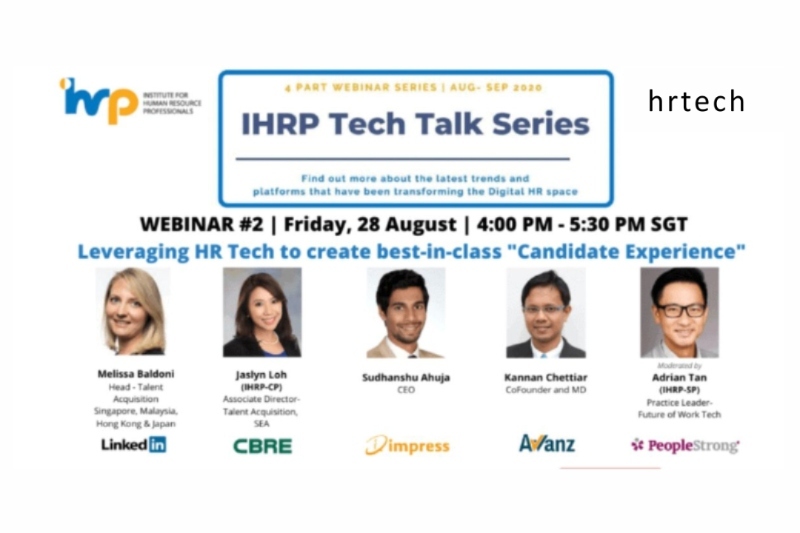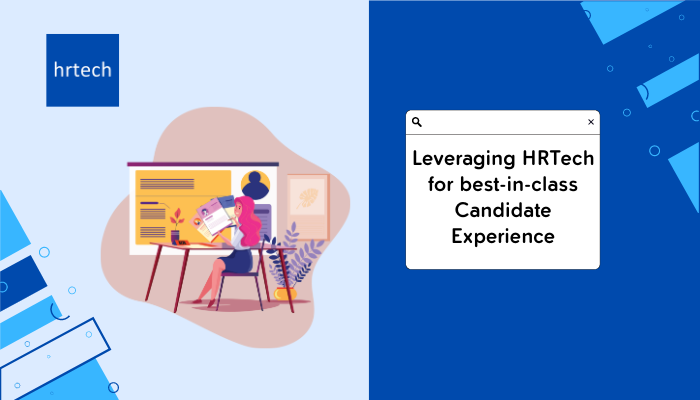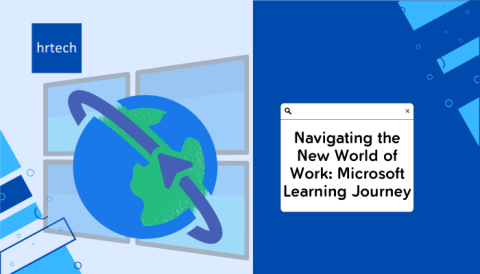Engagement is not an aspect that organisations should focus after a Candidate joins. It should start right from the time a Candidate shows interest in joining the organisation.

Institute for Human Resource Professionals (IHRP) HRTech Taskforce has been focused on enabling the Singapore HR community to adopt a Digital mindset and future-proof them by making them HRTech-ready. Harnessing the new-age technologies can enable HR to gain greater efficiencies and free up their time for strategic value-add activities that help their organisations transform and grow.
CANDIDATE EXPERIENCE AND ITS IMPORTANCE
Engagement is not an aspect that organisations should focus after a Candidate joins. It should start right from the time a Candidate shows interest in joining the organisation.
To enable organisations in this endeavor to enhance the “Candidate Experience”, there is an urgent need for HR and Talent Acquisition teams to adopt technology in a big way.
Adopting best in-class technology to the recruitment process adds value to the organisation’s “employer brand” and enhances positive candidate experience. There are varied tech solutions for every step of the hiring process, and employers can leverage them to make the entire process effectively seamless and create a personalized experience.
Webinar #2 in the 4-part IHRP Tech Talk series talked about “Leveraging HRTech for best-in-class Candidate Experience” (The Tech Talk Series is being organised by IHRP in association with hrtech.sg).
The webinar was moderated by Adrian Tan (Practice Leader -Future of Work Tech at PeopleStrong) , IHRP HRTech CoP Taskforce Member and cocreator of the Singapore HRTech Market Map 2020
For those who missed the webinar, here is a summary:
USE OF TECHNOLOGY CUTS ACROSS TALENT JOURNEY
Melissa Baldoni(Head – Talent Acquisition, Singapore, Malaysia, Hong Kong & Japan) at LinkedIn shared that it is becoming more and more important that HR needs a strong base in technology by using data and insights to support employees and advise the business to provide best in class experience. A core HR platform is a base for gathering key data points and using those insights to attract talent (employer branding), create an experience for candidates at the hiring stage or during the entire lifecycle of the employee till he leaves the organisation, even beyond.
FIGURE 1: Stages of Employee Lifecycle where LinkedIn data insights are used. Source: LinkedIn
Figure 1, shows the various Stages of employee lifecycle of PLAN-HIRE-DEVELOP where technology is used in various capacities to gather data and generate insights to make informed business decisions.
Technology and data at every step helps generate insights to understand the talent market: in-demand skills requiring investment; projecting future skills demand; and inputs around the talent pool (like geographic locations, skills, availability and engagement levels). All these can help the TA teams to create a talent pipeline as part of the sourcing strategy; build a strong talent brand (when compared to peers) and effectively engage with candidates. Using intelligent and intuitive Applicant Tracking Systems can help Talent Acquisition teams to attract, engage, nurture, and hire the best candidates and ensure an enriching candidate experience.
FIGURE 2: Various touch points at which technology is being use for engaging potential candidate through to hiring. Source: LinkedIn
Melissa showcased case studies on how Technology is being used by LinkedIn to attract, engage and hire diverse talent and achieve considerable improvement in Talent engagement (from 3% to 16%), Job conversion rate (from 15% to 20%) and reduction in time to hire (from 48 days down to 40 days).
IMPLEMENTING TECHNOLOGY
Jaslyn Loh (Associate Director, Talent Acquisition, SEA at CBRE) shared the digital transformation journey of the CBRE Talent Acquisition team in implementing ATS and CRM systems to address challenges and specific location needs (such as maturity of the HR/Talent functions, brand awareness , inconsistencies and inefficiencies in processes, address a multi-generational and multi-lingual workforce that was resulting in high volume hiring and turnover).
FIGURE 3: ROI achieved by CBRE TA Team post implementation of Avature CRM/ATS system. Source: CBRE
The CBRE Talent Acquisition team observed significant impact in terms of time, effort and dollars were seen across various metrics post implementation the CRM and ATS system.
The ROI was achieved by addressing three key areas: create efficiency through shared capabilities, improve effectiveness through enhancing the ability to support the business; and the ability to scale to establish a strong foundation for future growth.
The recruitment team at CBRE Asia was able to reduce/remove inefficiencies in the recruitment process by automating non value-added tasks, centralizing and standardizing the recruitment process through a shared service capability thereby freeing up time for more strategic activities and improve candidate experience.
TRENDING TECHNOLOGIES IN THE HRTECH LANDSCAPE
A large majority of the participants during the webinar when polled about “Which technology are you currently evaluating in the Talent Acquisition space for your organization?” indicated that they were looking at evaluating screening technologies for their Talent Acquisition teams. Technologies such as video interviews, assessments, chatbots and automated background checks being some of the other technologies available in this space.
RECRUITMENT AUTOMATION THROUGH AI- CHATBOTS
Sudhanshu Ahuja(CEO of impress.ai) shared his thoughts on how traditionally a lot of recruiters were spending majority of their time in shortlisting, qualifying applicants o gut based or unstructured methods leading to lack of ownership, low visibility, and quality of applicants.
FIGURE 5: Benefits realized post implementation of recruitment automation chatbot. Source : impress.ai
Sudhanshu highlighted that using technology like machine learning and AI engines to improve and automate objective screening of applicants not only improved cost of hire (by over 30%), but also improved the reach of recruiting channels by 5 times, reduced screening time from 7 days to just 30 minutes per candidate and in turn improved candidate experience.
FIGURE 6: DBS Case study by impress.ai. Source: impress.ai
Sudhanshu also showcased one of the many successful case studies in impress.ai’s virtual recruiter (chatbot implementation) of DBS, where the bank was able to digitally transform talent acquisition process to increase front-of-funnel gains, optimize talent acquisition for better candidate experience – with almost 98% of the FAQ’s being answered by the bot itself, leading to more than 75% reduction in candidate qualification time which can be redirected to other touch intensive stages in recruitment.
AUTOMATED BACKGROUND CHECKS AND BLOCKCHAIN TECHNOLOGY
Effective background screening provides companies with the comfort of verifying candidate educational background, work experience, and any possible criminal history by verifying candidate educational and work experience and understanding the pertinent details of their work and criminal history. Kannan Chettiar( Co-Founder & CEO of Avvanz) shared some use cases Technology company achieved significant cost savings, reduced turnover, and enhanced security, integrity and morale of the workforce through the use of automated background checks.
FIGURE 7: Case study on Automating Background check in a Technology company. Source: Avvanz
Traditionally, conducting background checks have been considered time consuming and labor-intensive process. Automating the background screening in the hiring process can replace manual, paper-based processes with workflows that allow HR teams to conduct background checks with ease and efficiency.
FIGURE 8: Using Blockchain for Avvanz for background screening. Source: Avvanz
Blockchain is finding its use in the background check industry that aims to match verified CV details to the job requirements thereby resulting in (almost) immediate turnaround at a significant lower cost. With the mainstream use of blockchain employee verification, high-quality candidates can be made available to companies at a lesser cost and at swift timelines. Avvanz platform pre-verifies key background checks with sources for candidates for various static data like- education, database checks, employment checks etc. eliminating the cost of redo the checks once it is stored on tokens in blockchain technology.
CONCLUSION
The interactive webinar reiterated how automation and technology tools can be used across the recruitment process to improve efficiencies in workflow, increase effectiveness, using data and insights to tailor candidate personas enhance the candidate experience.
ADDITIONAL RESOURCES
Watch Webinar
Summary and Video of Webinar 1 in the series- “Robotic Process Automation: Driving HR Transformation”
About the author :

Swechha Mohapatra (IHRP-CP, Associate CIPD) is a Senior Consultant – Digital HR at hrtech and has over 7 years of global experience in various Talent functions. She is a passionate HRTech evangelist, a member of the member of the IHRP HRTech CoP Taskforce and an avid learner who is certified Six Sigma-Green Belt with a background of MBA (Specialization in HR and IT) and Master’s in Labor Laws and Labor Welfare.





